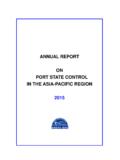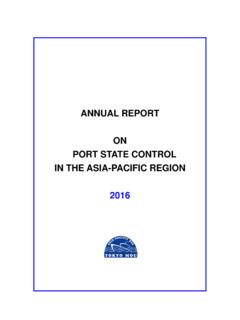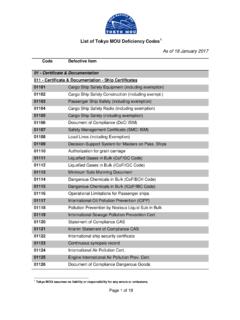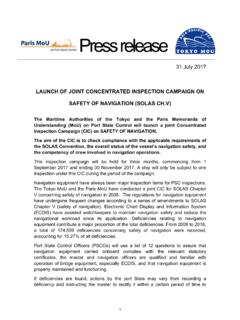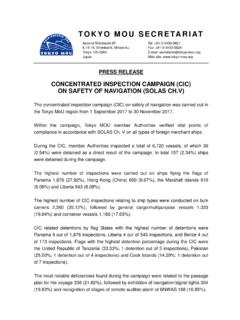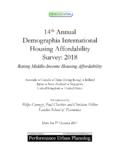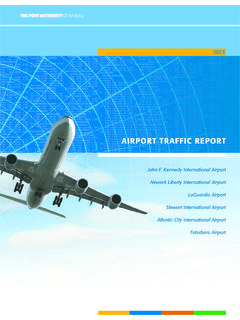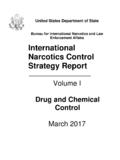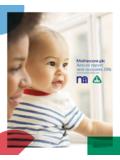Transcription of ANNUAL REPORT ON PORT STATE CONTROL IN …
1 ANNUAL REPORT ON PORT STATE CONTROL IN THE ASIA-PACIFIC REGION 2017 This work is copyright. It may be reproduced in whole or part subject to the inclusion of an acknowledgement of the source but not for commercial use or sale. Further information may be obtained from: The Tokyo MOU Secretariat Ascend Shimbashi 8F 6-19-19 Shimbashi Minato-ku, Tokyo Japan 105-0004 Tel: +81-3-3433-0621 Fax: +81-3-3433-0624 This REPORT is also available at Tokyo MOU web-site ( ) on the Internet. MEMORANDUM OF UNDERSTANDING ON PORT STATE CONTROL IN THE ASIA-PACIFIC REGION FOREWORD We are pleased to present the ANNUAL REPORT on Port STATE CONTROL in the Asia-Pacific Region 2017. The most important event during 2017 was the successful organization of the 3rd Joint Ministerial Conference of the Paris and Tokyo Memoranda on Port STATE CONTROL , held in Vancouver, Canada, on 2 - 4 May 2017.
2 This Conference will not only promote the PSC activities of the two MOUs but also facilitate the achievement of responsible and sustainable shipping of the industry. The Ministerial Declaration, signed at the Conference, requests the member Authorities to take specific steps to reach the ultimate objective of eliminating substandard ships. To this end, the Tokyo MOU will develop the actions to be taken and monitor progress made thereof in the coming years. This ANNUAL REPORT summarises the port STATE CONTROL developments and activities of the Tokyo MOU in 2017. Moreover, the REPORT also provides port STATE CONTROL statistics and analysis on the results of inspections carried out by member Authorities during the year. It is worth to note that the number of detentions during the year has decreased to 941 in 2017.
3 This is the lowest number and the first time less than 1,000 during the past two decades. However, on the other hand, average number of detainable deficiencies per detention has been increasing in the last three years. This may be interpreted as a trend that conditions of some substandard ships are becoming worse. Therefore the Tokyo MOU will need to further enhance and strengthen measures on inspection of under-performing and substandard ships. Carlos Fanta Hideo Kubota Chair Secretary Port STATE CONTROL Committee Tokyo MOU Secretariat MEMORANDUM OF UNDERSTANDING ON PORT STATE CONTROL IN THE ASIA-PACIFIC REGION CONTENTS page OVERVIEW General introduction .. 1 Review of year 2017 .. 2 The Port STATE CONTROL Committee .. 3 Technical Working Group (TWG) .. 5 The Third Joint Ministerial Conference .. 6 The Asia-Pacific Computerized Information System (APCIS).
4 6 Training and seminars for port STATE CONTROL officers .. 7 Co-operation with other regional port STATE CONTROL regimes .. 9 PORT STATE CONTROL UNDER THE TOKYO MOU, 2017 Inspections .. 11 Detentions .. 11 Deficiencies .. 12 Overview of port STATE CONTROL results 2007-2017 .. 13 ANNEX 1 -- STATUS OF THE RELEVANT INSTRUMENTS .. 20 ANNEX 2 -- PORT STATE INSPECTION STATISTICS .. 23 Statistics for 2017 .. 23 Summary of port STATE inspection data 2015-2017 .. 33 ANNEX 3 -- ORGANIZATION STRUCTURE OF THE TOKYO MOU .. 53 Explanatory Note on the Black-Grey-White Lists .. 54 MEMORANDUM OF UNDERSTANDING ON PORT STATE CONTROL IN THE ASIA-PACIFIC REGION LIST OF FIGURES AND TABLES page Figure 1 Inspection percentage .. 14 Figure 2 Inspection per ship risk profile .. 14 Figure 3 Port STATE inspections - contribution by Authorities .. 15 Figure 4 Type of ship inspected .. 15 Figure 5 Detentions per flag.
5 16 Figure 6 Detention per ship type .. 16 Figure 7 Deficiencies by main categories .. 17 Figure 8 Most frequent detainable deficiencies .. 17 Figure 9 No. of inspections .. 18 Figure 10 Inspection percentage .. 18 Figure 11 No. of inspections with deficiencies .. 18 Figure 12 No. of deficiencies .. 19 Figure 13 No. of detentions .. 19 Figure 14 Detention percentage .. 19 Figure 15 Comparison of inspections per ship type .. 39 Figure 16 Comparison of detentions per ship type .. 39 Figure 17 Comparison of inspections with deficiencies per ship type .. 41 Figure 18 Comparison of number of deficiencies by main categories .. 47 Figure 19 Comparison of most frequent detainable deficiencies .. 49 Table 1 Status of the relevant instruments .. 20 Table 1a Status of MARPOL 73/78 .. 22 Table 2 Port STATE inspections carried out by Authorities .. 23 Table 2a Port STATE inspections on maritime security.
6 24 Table 3 Port STATE inspections per ship risk profile .. 25 Table 4 Port STATE inspections per flag .. 26 Table 5 Port STATE inspections per ship type .. 29 Table 6 Port STATE inspections per recognized organization .. 30 Table 7 Deficiencies by categories .. 32 Table 8 Black Grey White Lists .. 33 Table 9 Inspections and detentions per flag .. 35 Table 10 Inspections and detentions per ship type .. 40 Table 11 Inspections with deficiencies per ship type .. 42 Table 12 Inspections and detentions per recognized organization .. 43 Table 13 Performance of recognized organization .. 45 Table 14 Comparison of deficiencies by categories .. 48 Table 15 Comparison of most frequent detainable deficiencies .. 50 Table 16 List of under-performing ships .. 51 MEMORANDUM OF UNDERSTANDING ON PORT STATE CONTROL IN THE ASIA-PACIFIC REGION 1 OVERVIEW GENERAL INTRODUCTION The ANNUAL REPORT on Port STATE CONTROL in the Asia-Pacific Region is published under the auspices of the Port STATE CONTROL Committee of the Memorandum of Understanding on Port STATE CONTROL in the Asia-Pacific Region (Tokyo MOU).
7 This ANNUAL REPORT is the twenty-third issue and covers port STATE CONTROL activities and developments in the 2017 calendar year. The Memorandum was signed in Tokyo on 1 December 1993 and came into effect on 1 April 1994. In accordance with the provisions of the Memorandum, Authorities that have signed and formally accepted the Memorandum or that have been accepted by unanimous consent of the Port STATE CONTROL Committee become full members. Currently, the Memorandum has 20 full members, namely: Australia, Canada, Chile, China, Fiji, Hong Kong (China), Indonesia, Japan, Republic of Korea, Malaysia, the Republic of the Marshall Islands, New Zealand, Papua New Guinea, Peru, the Philippines, the Russian Federation, Singapore, Thailand, Vanuatu and Viet Nam.
8 A maritime Authority that has declared its intention to fully adhere to the Memorandum within a three-year period may be accepted as a co-operating member by unanimous consent of the Port STATE CONTROL Committee. Panama is currently participating in the Tokyo MOU as a co-operating member Authority. The main objectives of the Memorandum are to establish an effective port STATE CONTROL regime in the Asia-Pacific region through co-operation of its members, harmonization of the members activities, to eliminate sub-standard shipping, to promote maritime safety and security, to protect the marine environ- ment and to safeguard seafarers working and living conditions on board ships. The Port STATE CONTROL Committee established under the Memorandum monitors and controls the implementation and on-going operation of the Memorandum.
9 The Committee consists of representatives from the member Authorities, co-operating member Authorities and observers. Observer status has been granted to the following maritime Authorities and inter-governmental organizations by the Committee: Democratic People s Republic of Korea, Macao (China), Samoa, Solomon Islands, Tonga, United States Coast Guard, the International Maritime Organization (IMO), the International Labour Organization (ILO), the Paris MOU, the Vi a del Mar Agreement, the Indian Ocean MOU, the Black Sea MOU, the Riyadh MOU and the Caribbean MOU. The Secretariat of the Memorandum is located in Tokyo, Japan. The Asia-Pacific Compu- terized Information System is established in the Russian Federation. For the purpose of the Memorandum, the following instruments are the basis for port STATE CONTROL activities in the region: MEMORANDUM OF UNDERSTANDING ON PORT STATE CONTROL IN THE ASIA-PACIFIC REGION 2 the International Convention on Load Lines, 1966; the Protocol of 1988 relating to the International Convention on Load Lines, 1966, as amended; the International Convention for the Safety of Life at Sea, 1974, as amended; the Protocol of 1978 relating to the International Convention for the Safety of Life at Sea, 1974; the Protocol of 1988 relating to the International Convention for the Safety of Life at Sea, 1974.
10 The International Convention for the Prevention of Pollution from Ships 1973, as modified by the Protocol of 1978 relating thereto, as amended; the International Convention on Standards for Training, Certification and Watchkeeping for Seafarers, 1978, as amended; the Convention on the International Regulations for Preventing Collisions at Sea, 1972; the International Convention on To nnage Measurement of Ships, 1969; the Merchant Shipping (Minimum Standards) Convention, 1976 (ILO Convention No. 147); the Maritime Labour Convention, 2006; the International Convention on the CONTROL of Harmful Anti-fouling Systems on Ships, 2001; the Protocol of 1992 to amend the International Convention on Civil Liability for Oil Pollution Damage, 1969; and the International Convention for the CONTROL and Management of Ships Ballast Water and Sediments, 2004.
